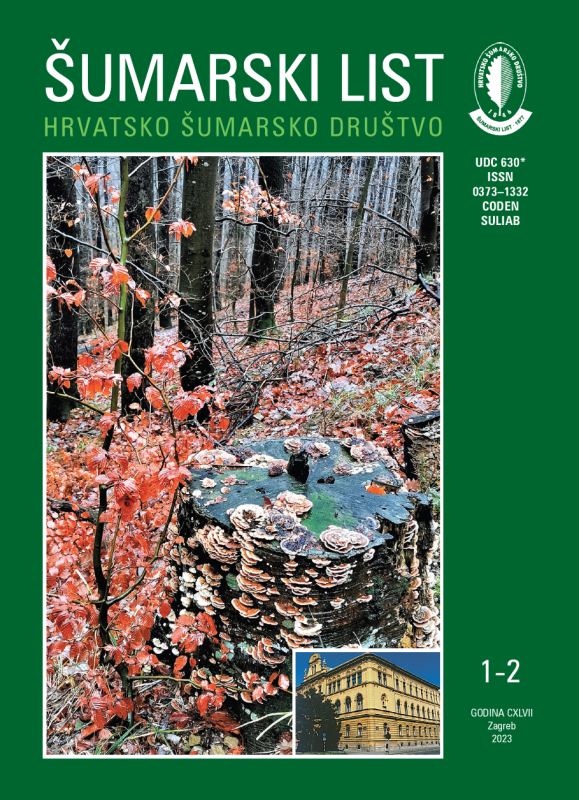
broj: 1-2/2023
pdf (8,7 MB) |
|
||||||||||||||
| RIJEČ UREDNIŠTVA | ||
| Uredništvo | ||
| How is the leased forestland used? pdf HR EN | 5 | |
| IZVORNI ZNANSTVENI ČLANCI | ||
| Ida Katičić Bogdan, Višnja Jurkić, Ivana Brlek, Marko Bačurin, Saša Bogdan | UDK 630* 165.+181.8 (001) https://doi.org/10.31298/sl.147.1-2.1 | |
| Genetic diversity of reproductive and phenological traits and their interrelationships in a clonal seed orchard of Wild Cherry (Prunus avium L.) pdf HR EN | 7 | |
| Krunoslav Teslak, Marijana Andabaka, Andrea Mertini, Karlo Beljan, Mislav Vedriš | UDK 630* 622+631 (001) https://doi.org/10.31298/sl.147.1-2.2 | |
| Choice of adaptive forest management model based on long-term projection in dinaric fir-beech stands pdf HR EN | 21 | |
| Milica Marčeta, Ljiljana Keča, Stjepan Posavec, Sreten Jelić | UDK 630*901 (001) https://doi.org./10.31298/sl.147.1-2.3 | |
| Socio-economic characteristics of forestry companies in the Republic of Serbia pdf HR EN | 39 | |
| Mirzeta Memišević Hodžić, Dalibor Ballian | UDK 630* 164 (001) https://doi.org/10.31298/sl.147.1-2.4 | |
| Variability of leaf morphological traits of european black poplar and hybrid black poplars in the clone archive in Žepče pdf HR EN | 53 | |
| Mehmet Kalkan, Mustafa Yilmaz, Rasim Alper Oral | UDK 630* 164 (001) https://doi.org/10.31298/sl.147.1-2.5 | |
| The morphological and chemical variability of Turkish Hazel (Corylus colurna L.) fruits in Turkey pdf HR EN | 65 | |
| PREGLEDNI ČLANCI | ||
| Hubert Codrow, Anna Wierzbicka, Maciej Skorupski | UDK 630* 156 https://doi.org/10.31298/sl.147.1-2.6 | |
| Factors shaping teenagers and young adults’ approach to hunting : a review of the literature pdf HR EN | 75 | |
| Summary Hunting is an important element in the protection of the natural environment and biodiversity. Demographic changes and people’s distance from nature are causing society to polarize their perception of hunting. Some have ‘’Bambi Syndrome’’ and others so-called ‘’Nature Deficit disorder’’. Factors shaping attitude toward hunting are: sex, age and place of residence: girls and city based children are generally against hunting. Future of wildlife management models largely depends on the attitudes of people towards it in the coming decades. This attitudes are shaping by many different factors but it is lack of knowledge about it. For this purpose, the attitude of young people to hunting should be thoroughly and multidimensionally examined. Key words: attitude toward hunting; young adults; teenagers | ||


